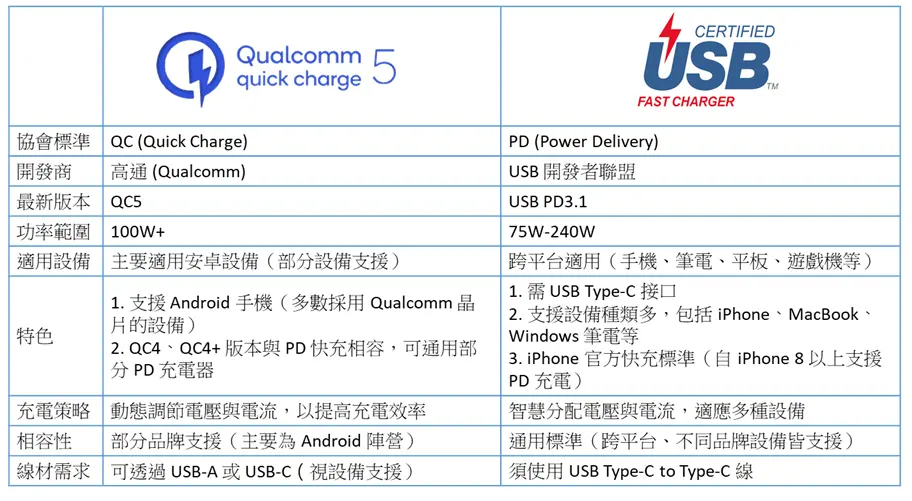PD (Power Delivery) is a fast-charging technology developed by the USB-IF
organization to meet the growing charging demands of modern electronic devices.
With PD technology, charging times are significantly reduced while ensuring
compatibility with a wide range of devices and guaranteeing a safe and stable charging process.
1.Multi-stage Voltage Adjustment: PD charging supports
multiple voltage outputs, including 5V, 9V, 12V, 15V, and 20V, to meet the needs of different devices, such as::
- Phones usually use 5V or 9V
- Tablets and laptops usually use 15V or 20V
- The PD 3.1 standard can reach up to 48V (240W), supporting larger power requirements.
2.Smart Charging Mechanism: PD charging can automatically adjust the charging power based on the device's battery level.
- When the battery level is below 20%, the system will provide high power for fast charging.
- When the battery level exceeds 80%, the charging speed will be reduced to extend battery life.
3.Relies on the USB Type-C Interface: PD charging uses the USB Type-C interface for power delivery, which has the following features:
- Reversible design for easier use.
- High-performance output for stable power supply and fast data transmission.
1.Rapid Charging: PD charging speeds are 50% - 70% faster compared to traditional USB charging. For example:
- With a 20W PD charger, an iPhone can be charged to 50% in just 30 minutes.
- Traditional charging methods may take 2 to 3 times longer.
2.One Charger, Many Devices: With a single PD charger, you can power multiple devices, including:
- Smartphone(iPhone、Android)
- Laptop(MacBook、Windows)
- Tablet(iPad Pro)
- Gaming Devices(Nintendo Switch)
- PD-Compatible Accessories(Wireless Earbuds, Power Banks,etc)
3.Lightweight and Portable: Modern PD chargers often use Gallium Nitride (GaN) technology, which makes them smaller and more efficient at dissipating heat. This makes them perfect for travel and office use.
4.Smart Safety Protection: PD chargers come with multiple built-in protection mechanisms, such as:
- Over-current Protection: Prevents a current overload from damaging the device.
- Over-voltage Protection: Prevents abnormal voltage during charging.
- Temperature Monitoring: Ensures the device operates within a safe range.
1.Verify Your Device's Power Requirements: Different devices have different power needs for PD, for example:
- The optimal PD charging wattage for an iPhone is 20W.
- A 16-inch MacBook Pro requires a 140W PD charger.
2.Choose the appropriate voltage and current
- Smartphones & Small Devices: A 30W or 45W charger is recommended.
- Laptop Charging: Choose 65W or higher. For high-power devices, a 140W charger is recommended.
3.Prioritize using a Type-C to Type-C charging cable. These USB-C cables support the PD protocol, which provides a more stable and efficient fast-charging experience.
4.Look for products with safety certifications: When making a purchase, confirm that the product has safety certifications like UL (U.S.) or BSMI (Taiwan) to ensure the charger meets international standards.
1.Check If Your Device Supports PD Charging: You can verify this by checking your device's specifications or its official website. For example::
- iPhone 8 and newer models support PD fast charging.
- Most iPad Pro and MacBook models come with built-in PD charging compatibility.
2.Use the appropriate charger and cable
- Choose a compatible PD charger and make sure its power output meets your device's requirements.
- Use a USB Type-C cable that is compliant with the PD standard.
3.Proper Connection and Use
- Plug it into a PD-compatible charging port (usually a Type-C port with a PD logo).
- Ensure a good operating environment and avoid high temperatures, which can affect the charger's lifespan.
1.What is the difference between PD charging and other fast-charging technologies?
PD is a universal standard with a wide range of applications, while technologies like VOOC (OPPO) and Dash (OnePlus) typically only support specific brands.
2.Does PD Charging Damage the Battery?
No. PD charging intelligently regulates voltage and current, which can effectively extend battery life and reduce the risk of overcharging.
3.Do I have to use an original PD charger?
It is not mandatory, but we recommend choosing a certified third-party PD charger to ensure both safety and compatibility.
4.Do all USB Type-C ports support PD charging?
Not necessarily. Some Type-C ports only support data transfer. You need to check if the device or charger supports the PD fast-charging protocol.
- USB-IF: Introduction to USB Power Delivery → Link:https://www.usb.org/
- Apple Official Support: About PD Fast Charging → Link:https://support.apple.com/
- CNET: PD Technology and Impact → Link:https://www.cnet.com/
- Wikipedia: USB Power Delivery Explained → Link:https://en.wikipedia.org/wiki/Main_Page

| 協會標準 | QC (Quick Charge) | PD (Power Delivery) |
| 開發商 | 高通 (Qualcomm) | USB 開發者聯盟 |
| 最新版本 | QC5 | USB PD3.1 |
| 功率範圍 | 100W+ | 75W-240W |
| 適用設備 | 主要適用安卓設備(部分設備支援) | 跨平台適用(手機、筆電、平板、遊戲機等) |
| 特色 | 1. 支援 Android 手機(多數採用 Qualcomm 晶片的設備) 2. QC4、QC4+ 版本與 PD 快充相容,可通用部分 PD 充電器 |
1. 需 USB Type-C 接口 2. 支援設備種類多,包括 iPhone、MacBook、Windows 筆電等 3. iPhone 官方快充標準(自 iPhone 8 以上支援 PD 充電) |
| 充電策略 | 動態調節電壓與電流,以提高充電效率 | 智慧分配電壓與電流,適應多種設備 |
| 相容性 | 部分品牌支援(主要為 Android 陣營) | 通用標準(跨平台、不同品牌設備皆支援) |
| 線材需求 | 可透過 USB-A 或 USB-C(視設備支援) | 須使用 USB Type-C to Type-C 線 |





